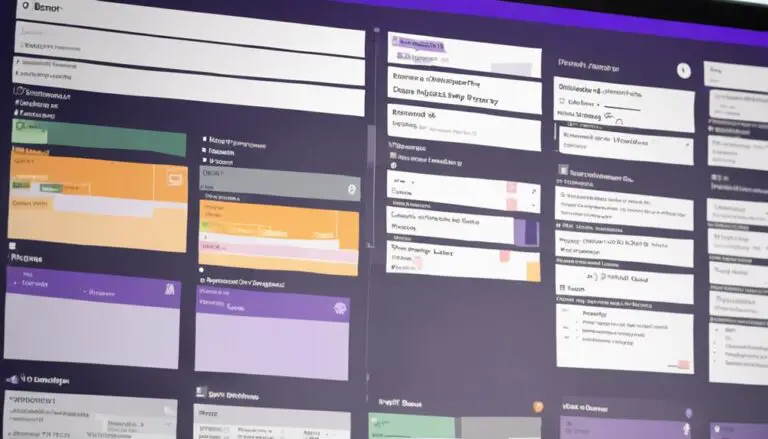Imagine your Kanban team as a well-tuned orchestra where each member plays a crucial role in creating harmonious melodies. Just like in music, the key to utilizing sprints effectively lies in synchronized collaboration and precise timing.
By blending the flexibility of Kanban with the structured cadence of sprints, teams can achieve a rhythm that optimizes workflow and delivery. But how exactly can you orchestrate this seamless integration for maximum impact?
Let's explore the nuances of merging Kanban principles with sprint practices to create a symphony of productivity and efficiency.
Key Takeaways
- Kanban teams use sprints to set clear sprint goals aligned with project objectives.
- They establish a structured cadence for planning, executing, and reviewing work efficiently.
- Kanban teams balance flexibility with a structured approach to boost productivity.
- They focus on completing tasks within defined timeframes to drive continuous progress.
Leveraging Sprints in Kanban Teams
In Kanban teams, leveraging sprints effectively involves setting a clear Sprint Goal to focus on specific deliverables. By incorporating sprints into your workflow, your team can establish a rhythm for continuous improvement and timely delivery. Kanban team velocity estimation can also be used to forecast the amount of work that can be completed in future sprints, helping the team to better plan and prioritize their tasks. By regularly reviewing and adjusting the sprint goals and timelines, the team can optimize their performance and ensure they are consistently delivering value to their customers. Additionally, incorporating sprints into a Kanban framework can help teams to identify and address any bottlenecks or inefficiencies in their process, leading to greater overall productivity and quality.
Sprints in Kanban provide you with regular opportunities to gather feedback and make necessary adjustments, ultimately enhancing the visibility of your workflow. When planning sprints in Kanban, it's essential to prioritize your work items from the backlog strategically. This prioritization ensures a smooth and steady flow of tasks throughout the sprint duration.
Through the integration of sprints in Kanban, your team can strike a balance between flexibility and structured, time-bound iterations, leading to optimized performance. Embrace the concept of sprints within your Kanban framework to enhance your team's productivity, collaboration, and overall effectiveness in achieving your product development goals.
Effective Sprint Planning in Kanban
To effectively plan sprints in Kanban, prioritize tasks based on workflow optimization and establish clear sprint goals for focused delivery. Sprint planning with Kanban involves breaking down work into manageable tasks that align with the team's capacity and expertise.
By setting specific sprint goals, Kanban teams can maintain a clear direction and purpose throughout the sprint. This process not only enhances collaboration but also ensures that the team is working towards a common objective. Additionally, incorporating iterative development practices allows for continuous improvement and adjustments based on feedback received during the sprint.
Kanban teams benefit from the flexibility offered by using sprints, enabling them to adapt to changing priorities and deliver value incrementally. By optimizing workflow and emphasizing the importance of sprint goals, teams can streamline their processes and achieve efficient sprint planning in Kanban.
Integrating Sprints for Efficiency
Consider how integrating sprints within Kanban methodology transforms team efficiency through structured cycles of iterative value delivery.
- Efficiency Boost: Integrating sprints enables Kanban teams to work towards time-bound goals, enhancing productivity and focus.
- Incremental Value: Sprints help in delivering incremental value in short iterations, allowing for quicker feedback and adjustments.
- Structured Cadence: By incorporating sprints, Kanban teams establish a structured cadence for planning, executing, and reviewing work, fostering efficiency and alignment.
- Increased Collaboration: Sprints promote increased collaboration among team members, as they work together towards achieving common sprint goals.
Embracing sprints in Kanban methodology not only ensures predictable delivery timelines but also fosters a balanced flow of work.
This approach encourages adaptability, continuous improvement, and team cohesion. By integrating sprints, Kanban teams can streamline their processes, work more efficiently, and deliver value consistently, ultimately leading to higher levels of productivity and satisfaction within the team.
Enhancing Productivity With Kanban Sprints
Enhance team productivity by strategically implementing Kanban Sprints to focus on completing specific tasks within defined timeframes.
Kanban teams benefit greatly from utilizing Sprints, as these time-limited work periods enable them to manage work efficiently and optimize their workflow. By adopting a structured approach through Kanban Sprints, teams can enhance productivity by staying goal-oriented and ensuring continuous progress.
The incremental value delivered through the completion of tasks within these Sprints helps teams to maintain momentum and drive towards achieving their objectives effectively. With Kanban Sprints, teams can break down larger projects into manageable segments, making it easier to track progress and make necessary adjustments along the way.
Strategies for Successful Sprint Implementation
Implementing effective strategies is key to maximizing the success of sprint implementation in Kanban teams. To ensure your sprints run smoothly and yield the desired outcomes, consider the following strategies:
- Set Clear Sprint Goals: Align sprint goals with the overall project objectives to maintain focus and direction throughout the sprint.
- Implement Time-Boxed Sprints: Utilize fixed durations for sprints to concentrate efforts on delivering valuable work increments efficiently.
- Break Down Tasks: Enhance collaboration and productivity by breaking tasks into smaller, manageable units for easier implementation during sprints.
- Conduct Regular Retrospectives: Schedule sprint retrospectives to promote continuous improvement and adaptability for future sprints, fostering a culture of learning and growth.
Frequently Asked Questions
How Does Kanban Work With Sprints?
When using Kanban with sprints, you integrate sprint planning, visualize workflow, limit work in progress, prioritize tasks, and hold daily standups. This collaboration enhances flow efficiency, optimizes processes, and fosters continuous improvement following agile principles.
What Is the Sprint Goal in Kanban?
In Kanban, the Sprint Goal is a specific objective set for each Sprint period. It focuses on achieving desired outcomes, guiding task prioritization, and fostering team collaboration. By delivering value and continuously improving, teams enhance workflow efficiency within set Sprint durations.
How Do You Run Kanban Effectively?
To run Kanban effectively, you focus on team collaboration, continuous improvement, visual management, limiting WIP, and flow efficiency. Conduct daily stand-ups, track cycle time, and make data-driven decisions. Embrace lean principles for better outcomes.
Do You Have Sprint Reviews in Kanban?
In Kanban, sprint reviews aren't part of the process. The focus is on continuous improvement through incremental changes. Team collaboration and customer feedback drive the iterative process. Performance metrics, agile practices, and time management ensure delivery expectations and quality assurance.
Conclusion
So there you have it! By blending the power of sprints with Kanban's flow-based approach, teams can sprint ahead with efficiency and productivity.
With WIP limits and a focus on flow metrics, collaboration and communication are streamlined, leading to smoother workflow and better outcomes.
Keep pushing forward with these strategies and watch your team soar to new heights!





